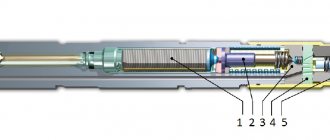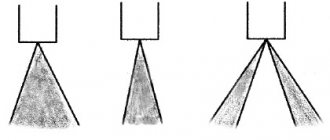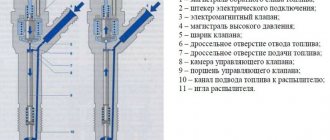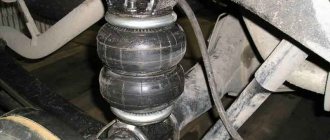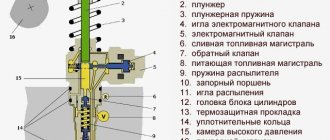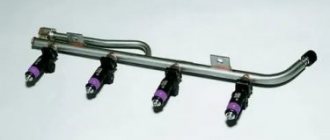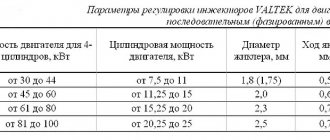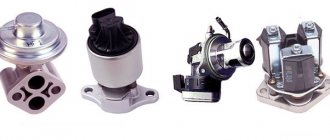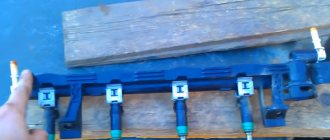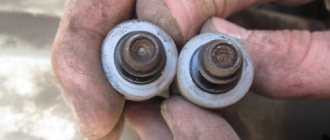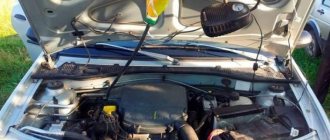Signs of a faulty diesel engine injector
Most often, a malfunction of diesel injectors is detected very quickly by the driver. But if the owner of a diesel car has no experience of owning such a car, then he may not immediately recognize the breakdown. The first thing you should pay attention to is the operation of the engine. At the first stages, no signs of breakdown appear. On the contrary, the car starts to drive a little better than usual. Yes, I didn’t make a mistake now. Everything is exactly like that. The fact is that due to faulty injectors, more fuel than required may enter the combustion chamber. Because of the rich mixture, the car starts to drive better.
If you miss this moment, then a smooth ride will gradually develop into a larger breakdown. After some time, you will begin to notice that the car began to smoke when starting, and the idle speed became unstable, and the speed began to fluctuate.
At the most advanced stages, fuel consumption increases significantly, and the car begins to smoke even when driving or sharply pressing the gas pedal. Gradually, as the injector pours fuel, it will begin to flow through the rings into the oil. This may cause the engine oil level to increase and its properties to deteriorate. And this can already lead to serious repairs.
What types of fuel injectors are there?
What will the cars of the future be like?
No matter how interested a person is in all the trends in the development of modern technologies. But imagining the car of the future is very difficult. The only thing that can be assumed is the development of machines towards environmental friendliness, autonomy and artificial intelligence. Most likely, in the future, the car will take over most aspects of driving, and the requirements for driving skill will be reduced to a minimum. But still. Let's try to imagine in which direction the machines will develop. Economy and environmental friendliness Today's development of power units is already striving to minimize the cost of petroleum products when operating vehicles. In addition, electric or hybrid vehicles are becoming increasingly popular. Therefore, we can assume that in the near future, cars equipped with internal combustion engines will become the lot of collectors and lovers of “antiques”. (adsbygoogle = window.adsbygoogle || []).push({}); And cars equipped with an electric motor and hydrogen fuel power plants are an everyday reality. What will this give? Firstly, the use of electrical energy will save the cost of operating vehicles and completely rid the atmosphere of harmful emissions from exhaust gases, but the increased need for electricity will most likely increase its cost. Therefore, we should expect the development of technologies in the production of hydrogen and power units using hydrogen as an energy source (there are already working prototypes that successfully use this type of power units). In addition, due to the oversaturation of large cities with cars, it can be assumed that the main fashion will come for ultra-compact cars that will be able to successfully compete with conventional standard-sized cars in megacities. Naturally, this trend will reduce scientists' concerns about environmental pollution from numerous cars. But another question arises - how to increase environmental friendliness and reduce the cost of obtaining electrical energy, as well as reduce the cost of producing hydrogen fuel. Transport and traffic safety The main idea of traffic safety in the future is its complete automation through autonomous control and coordination of road flow through a central server of the metropolis. By removing the human factor of error from the main risks, scientists suggest a reduction in road accidents by up to 95%. Also, due to the full introduction of automatic piloting, the interior of the car will undergo a significant change, which will no longer require a human driver. But this will not happen soon, since the first automated versions require constant human control, and the classic driver's seat with a steering wheel and pedals will remain for a long time. In addition, new technologies may appear in the manufacture of materials for the car body or other principles for designing a rigid frame that will ensure complete safety for the driver and passengers inside the cabin. According to some scientists, cars of the future will be equipped with special systems to support human life even in the most difficult conditions, and automated first aid kits that can save lives until rescue teams arrive. Car dimensions As mentioned above, the constant increase in automobile transport in cities dictates the need to create and purchase more compact car models. By combining the small size of a car with a centralized traffic control system, it will be possible to achieve a manifold increase in the capacity of modern streets while maintaining traffic safety at the highest level. Also, more compact dimensions will allow you to create spacious parking lots and completely forget about hours-long traffic jams. Based on modern developments, we can assume the emergence of mass use of airless tires, which will use the principle of load-distributing rubber spokes. For example, Bridgestone has been testing wheels built on this principle for several years. But now, these tires are used only on golf carts, and testing for civilian and trucks continues. This technology will significantly increase traffic safety by eliminating tire breaks or punctures. Modern cars Already, many automobile companies are developing and testing various configurations of cars with automated control based on the readings of video cameras and radars. But two companies have gone the furthest in their developments - Google (not focused on car production, but developing automatic piloting technology) and the most advanced company in automotive development plans - Tesla Motor (which has successfully launched a number of high-quality electric cars on the market, equipped with the most modern autopilot system on the market). civilian vehicles). But other companies are also trying to keep up with them, although they are at the stage of developing and testing their systems, which inspires hope that the principles of driving cars will soon be transformed and the entire road traffic will change. View the news
Why do injectors on a diesel engine fail?
The injectors on a diesel engine come out faster than on a gasoline engine. This is due to the fact that these motors have different operating principles. But in both cases, the culprit is low-quality fuel or untimely replacement of the fuel filter. If you service the car on time, the injectors should work for at least 150,000 km without replacement or repair. If you also use high-quality fuel, then the factory injectors should last 200-300 thousand km.
But, as a rule, the fuel used is not of the highest quality, and filters are rarely changed. Therefore, the injectors in modern diesel engines hardly last 150 thousand km. Then they become dirty and begin to dose fuel incorrectly. To fix this, you will have to at least mechanically clean them of deposits and dirt. It is better not to put this procedure on the back burner, but to entrust the work to people who understand this.
Therefore, fill in high-quality fuel and do maintenance on time. High-quality, timely car maintenance will help you avoid unpleasant breakdowns in the future.
Benefits of using an injector
The service life of high-pressure injectors cannot be compared with the carburetor control model. The electronically controlled system has a number of advantages that are noticeable immediately after starting the engine.
- The metered injection system provides significant fuel savings;
- Increasing the power of the power unit and its dynamic performance;
- Huge operating life and no need for maintenance;
- Easy to start the power plant regardless of weather conditions;
- Less engine wear and smoother acceleration;
- Acceptable level of exhaust gases.
The efficiency of the injection engine is superior to previous generation systems and represents a finely tuned mechanism. Electronic control makes it possible to use low pressure injectors or the Common Rail system for the most accurate fuel supply. The carburetor rarely fails, and the absence of the need for periodic adjustments makes such a system easy to use.
If you have any questions, leave them in the comments below the article. We or our visitors will be happy to answer them
Operating principle of a diesel engine injector
Let us describe the design of the part using the example of a primitive mechanical injector with 1 spring. In the side part there is a channel that provides a continuous supply of diesel fuel. Inside the nozzle chamber there is a movable barrier with a spring and a needle, which lowers as pressure increases. The needle rises, clearing the path of fuel to the atomizer.
Additionally, more advanced types of nozzles can be noted:
- Piezoelectric: the spring pusher is lowered under the influence of a piezoelectric element. This technology ensures high intensity of opening of the nozzle: fuel savings are achieved, while the internal combustion engine operates more smoothly.
- Electrohydraulic: the design includes inlet and drain throttles, as well as an electromechanical valve. The operating mode of the components is regulated by the engine control unit.
- Pump injectors: used in engines that do not have a high pressure fuel pump. Fuel is supplied directly to the injectors. Inside such spray devices there is its own plunger pair, which generates the pressure necessary for injection.
Due to excessive loads, the injector may fail due to a violation of the engine operating mode. Manufacturers claim a parts life of up to 200,000 km, but due to negative operational factors, wear of parts appears much earlier.
Checking diesel injectors
If there are signs of injector malfunction, they are checked. The procedure can be carried out both in a garage and at a service station using a diagnostic stand. The second method is the most optimal, but has disadvantages in the form of high cost of services and significant remoteness of the service. There are the following ways to check the serviceability of injectors:
1. With the diesel engine running, set the speed at such speeds when malfunctions in its operation can be heard especially clearly. The injectors are sequentially disconnected from the high pressure line by loosening the union nut on the corresponding pump fitting. If a faulty injector is disconnected, the engine's performance will not change.
2. Check with a maximeter, which is made in the form of a special nozzle with a calibration scale for setting the required diesel fuel injection pressure. The device is a control sample, with the help of which the spray efficiency and the correspondence of the actual pressure with the required one at the time of injection are analyzed.
3. Check using a control sample of the working injector, which is compared with the others. To do this, install a tee on the fuel equipment, with the help of which the working and tested injector are simultaneously installed. Loosen the nuts on the remaining pipelines leading from the high-pressure pump to the untested injectors, shutting off the fuel supply. The decompression mechanism is set to maximum fuel supply and the engine crankshaft begins to rotate. If there is a malfunction, the injector will show differences from the standard in terms of the start time and quality of injection.
Causes of injector malfunction
Repair of diesel injectors may be required for the following reasons:
- Low quality diesel fuel: the scourge of all diesel drivers. Due to impurities in the fuel, the atomizer becomes clogged; the dosage and fuel supply mode are violated.
- Poor assembly quality of the injection component or manufacturing defect: the injector does not withstand operating conditions, the part as a whole or individual components fails.
- Mechanical damage caused by incorrect operation of adjacent internal combustion engine systems.
Usually the breakdowns are of the following nature: the spray angle and the amount of fuel supplied changes, the integrity of the housing is compromised, and the needle stroke worsens.
Operating principle of a mechanical nozzle
The operating principle of a diesel power system with mechanically controlled injectors is as follows. The high pressure fuel pump (HPFP) is supplied with fuel from the fuel tank. The feed pump is responsible for the supply, which creates the low pressure necessary to pump diesel fuel through the fuel lines.
Next, the fuel injection pump, in the required sequence, distributes and pumps fuel under high pressure into the lines leading to the mechanical injector. Each nozzle of this type opens for the next injection of diesel fuel into the cylinders under the influence of high fuel pressure. The decrease in pressure causes the diesel fuel injector to close.
A simple mechanical injector has a body, a nozzle, a needle and one spring. In the device, the shut-off needle moves freely along the guide channel of the sprayer. The injector nozzle closes tightly at a time when there is no required pressure from the injection pump. At the bottom, the needle rests on the atomizer seal, which has a conical shape. The needle is pressed using a spring attached to the top.
The atomizer is one of the most important components among other elements in the design of an injection nozzle. Sprayers may have a different number of spray holes and differ in the way they regulate the fuel supply.
Simple diesel engines that have a split combustion chamber often have a single-hole atomizer with a needle. Diesel engines, which are based on direct fuel injection, are equipped with injectors with several spray holes. The number of holes in such a sprayer ranges from two to six.
The fuel supply is regulated depending on the design of the atomizer, since there are two main types of such solutions:
- sprayer with the ability to block channels;
- sprayer with overlapped volume;
In the first case, the injector needle shuts off the fuel supply by blocking each hole. The second type of nozzle means that the needle covers a kind of chamber at the bottom of the atomizer.
The fuel pressure pumped by the injection pump forces the needle to rise due to the presence of a special step on the surface of such a needle. Diesel fuel penetrates the housing under the specified step. At the moment when the fuel pressure is stronger than the force created by the pressure spring, the needle moves upward. This opens the nozzle channel. Diesel fuel under pressure passes through the atomizer and is sprayed in the form of a torch. This is how fuel injection is implemented.
Next, a certain amount of fuel, which is supplied by a high-pressure pump, will pass through the atomizer and enter the combustion chamber. After this, the pressure on the needle step begins to decrease, as a result of which the needle, under the force of the spring, returns to its original position and tightly closes the channel. Then the supply of diesel fuel to the sprayer stops completely.
Checking the functionality of the injector
There are several methods for checking the functionality of the sprayer. The easiest way to check the injector is with the engine running:
- Start the engine at idle speed.
- Start unscrewing the nozzles one by one.
- If after removal the engine performance deteriorates, then the removed injector is operational and should be returned to its place.
- By process of elimination you will find an injector, the removal of which will not change the operating mode of the internal combustion engine. This will be a broken device.
You can use a multimeter for diagnostics. In advance, you need to disconnect the battery terminals and disconnect the injector wiring, and then “check” each part with the device. On high resistance injectors, the device values will be in the range of 11 - 17 ohms; at low impedance the multimeter will show up to 5 ohms.
Tip: Having a maximeter will be a big advantage. The device is able to show the current pressure at which the sprayer is activated. It will also help identify defects regarding the spray angle and injection jet configuration.
Nozzle device
In essence, a modern injector is a valve based on a program-controlled electromagnet. It includes the following structural elements:
- rubber gasket;
- filter;
- connector;
- moving core induction coil controlled by ECU;
- core return spring;
- input manifold;
- spray needle;
- nozzle.
The injectors are located on the cylinder block head. How many there are depends on the total number of cylinders, since each requires one. The vast majority of passenger cars have 4 of them.
As for the layout, in most passenger cars the injectors are lined up in one row and mounted on a hollow metal tube through which fuel flows into them.
The easiest way to find out whether there are injectors in a particular engine and where they are located is to read the technical data sheet of the vehicle.
Before injectors began to be used on injection engines in conjunction with a control unit, they had a slightly different device. Instead of an induction coil with a movable core, they had a high-pressure valve, which was activated after the fuel was pumped by the fuel pump when a certain pressure was reached. Similar devices are still used on some models of diesel engines.
Troubleshooting
A faulty injector must be inspected. First, we look for leaks in the part body. If there are none, we proceed to disassembling the part. We fasten the part in a vice and knock out the spray nozzle by gently tapping it. Next, you need thorough cleaning: soak the parts of the nozzle in diesel fuel or solvent to remove carbon deposits. We remove soot and deposits with a fine steel grater. After cleaning is completed, you need to check the nozzle on the maximeter. If optimal injection parameters are achieved, the device is ready for installation in the engine.
In other cases, it is necessary to completely replace the nozzle on the defective nozzle. When installing a new part, carefully remove all factory grease, otherwise the device will not work.
If the nozzle continues to “flow” even after replacing the nozzle and thorough cleaning, pay attention to the performance of the spring with the pin - they may be worn out.
To clean the sprayer, use a compressor - the air pressure will knock out hard-to-reach dirt.
Nozzle installation
Before dismantling the device, mark all parts with a marker to avoid confusion. Be especially careful about marking high-pressure hoses. The nozzle is screwed in by hand as far as you can. Further tightening is performed with a dynamometer wrench. The tightening values are indicated in the motor manual. When installing the injector, bleed the air from the fuel system. On modern cars, this is enough to turn the starter several times; or use a manual pump (if available).
What is a nozzle
An injector is an integral part of the engine fuel system that supplies fuel to the cylinders at a certain time in a certain quantity. Fuel injectors are used in diesel, injection, and mono-injection power units. Today, there are several types of nozzles that are fundamentally different from each other.
Cases when the nozzle needs to be completely replaced
Let's list the main features:
- the resource declared by the manufacturer has been exhausted;
- there are breakdowns or other leaks in the housing;
- burnt nozzle nut: if the problem is not corrected at an early stage, the nozzle itself will become unusable.
Please note that on some engines, after installing a new injector, it is necessary to “bind” it to the engine: make changes to the settings of the control unit.
It is better to install the nozzle at a service station, since the station has bench equipment for adjusting and assessing the current condition of the part.
Diesel injectors:
a — YaMZ-236; b - KamAZ-740; 1 — spray needle; 2 - copper washer; 3 - annular cavity; 4— sprayer; 5— union nut; 6—pin; 7—ball; 8 — body; 9 — rod; 10 — spring plate; 11 - spring; 12 — adjusting screw, 13 — spring cup; 14 - lock nut; 15 — cap; 16 - gasket; 17 — bushing; 18 - mesh filter; 19 — fitting seal; 20 - fitting; 21 and 23 — channels; 22 — annular groove; 24 - brass glass; 25 — cylinder head; 26 — spacer; 27 - sealing ring; 28 — adjusting washers; 29 — support washer.
Design
The injector is the most important element in the injection system of gasoline engines. This is a solenoid valve that operates “under the command” of the ECU, the electronic engine control unit. After receiving pulses of a certain frequency, the ECU “measures” the dose of the required fuel, depending on the engine load and coolant temperature. The precise and well-functioning operation of this mechanism allows the engine to operate properly for a long time: lower fuel consumption, greater power and torque, easy engine starting at any temperature - all these are advantages of the well-functioning operation of the injector, but any malfunctions in its operation worsen the performance of the entire engine. Very often, the faulty operation of a gasoline engine is caused by electromagnetic injectors that do not perform their functions or are partially faulty. This is due to the fact that there is no electrical impulse to open the valve, perhaps the solenoid winding has broken, or the internal valves may be dirty. Dirty internal valves most often make themselves felt to the car owner in winter when starting an injection engine.
Operating principle of the injector
The simplest injector has the following elements in its design:
- Electronic control unit;
- Gasoline pump (electric);
- Injectors;
- Sensors;
- Pressure regulators.
As you can see, there is nothing too complicated in the design of the injector, at least as far as its mechanical part is concerned. In short, the operation of the injection system occurs as follows:
- The air flow sensor measures the mass of air entering the engine.
- This information is then transmitted to the injector control unit, along with other data (temperature of the power unit, crankshaft rotation speed, air temperature, speed and degree of throttle valve opening, and other parameters).
- The computer analyzes all this information and accurately calculates the amount of fuel (gasoline, diesel fuel, gas) that is required for combustion in the incoming air mass.
- Next, an electric discharge (of a certain duration) is supplied to the injector nozzles, which open, passing fuel from the fuel line into the intake manifold.
The most complex part of the entire injection system is the electronic control unit (abbreviated as ECU). It is a microcomputer that performs calculations according to a program stored in its memory. The program is designed in such a way that it manages to analyze all engine operating parameters and respond to changes in information received from external sensors.
That is why the following two components are extremely important for the correct operation of the injector: the exhaust gas catalytic converter and the oxygen sensor (lambda probe).
- Catalytic converter . Outwardly, it resembles honeycombs, which are covered with a special layer. Its task is to burn out unburned fuel escaping from the combustion chamber along with the exhaust gases. But it loses this ability after just a few fill-ups with leaded gasoline. However, it is not only fuel that can cause a malfunction. Often the neutralizer simply melts as a result of prolonged driving on an enriched mixture - the honeycombs are simply clogged with carbon deposits. This occurs as a result of a breakdown of the oxygen sensor or a malfunction in the ignition system.
- Oxygen sensor . Most often, cars are equipped with zirconium sensors, which warm up to operating temperature (over 300 °C) and provide the control unit with information about the state of the mixture, focusing on the composition of the exhaust. If the mixture is too rich or lean, the computer adjusts the fuel supply, increasing or decreasing its amount accordingly.
As you can see, the injector is a very complex mechanism. Therefore, we do not recommend carrying out operations such as cleaning the injector or repairing it yourself.
How to find the cause of the breakdown?
This is done using a special tester; first, they check the voltage supplied to the injectors (normal pressure is from 0 to 2-3V); if there is voltage, then everything is in order with the injector. Next, the injector valve windings are checked. During normal operation of the injectors, they have a resistance of 12-16 Ohms, in systems with turbocharging - 4-5 Ohms, and in systems with a monoinjector - 4-5 Ohms. The mobility of the injector solenoid valve is determined by instantly connecting the injector terminals to a power source, for example, to an engine battery. A normally operating injector will click slightly, this will indicate normal operation of the valve, and if the valve works but the cylinder does not, it means the injector is very dirty. At service stations, the level of contamination of injectors is checked using multitesters based on the duration of the pulses that the ECU sends to open the valve. If the nozzle is dirty, the pulse time increases. Also, if irregularities are detected in the engine’s operation, the toxicity of the exhaust gases can be checked. Their toxicity increases when the mixture is over-enriched, mixture formation deteriorates, and the combustible mixture cannot be ignited. If a three-component catalyst is installed in the car, then an increase in the content of nitrogen oxides can be an indicator of deterioration in the operation of the injectors. Moreover, if the foreign car is new, then unused fuel in the form of gases can quickly damage the catalyst.
Repair of diesel injectors
Contamination of the channels inside the injector through which fuel passes leads to poor fuel atomization and disruption of the formation of the air-fuel mixture. The most uniform spraying is disrupted by the resins contained in the solarium. Flushing can help eliminate the problem of poor fuel supply to the injectors. This procedure ensures the removal of contaminants inside the fuel channels. To implement this, the following methods are used:
1. Ultrasonic cleaning. An effective way to remove dirt, which is carried out using special equipment. The removed nozzles are placed in a special liquid and exposed to ultrasonic vibrations, during which the dirt in the nozzle is destroyed within a short time.
2. Flushing with fuel containing special additives. It is most popular among car enthusiasts, as it does not require the use of expensive equipment. It is the addition of an additive to the fuel, which, when passing through the injector, will dissolve deposits. The effectiveness of the method has not been proven.
3. Washing on the stand using special liquids. Purification occurs at high pressure due to circulation. The method is reliable and highly efficient.
4. Manual washing, which simulates the operation of a nozzle. A fairly effective and inexpensive method that does not require the use of special equipment. To carry it out, the nozzles are dismantled along with the rail and fixed above the container. The cleaning liquid is supplied through a transparent silicone tube. The injector dispenser is activated by electric current supplied through wires from the battery. Complete cleaning occurs after 5-10 minutes. spraying liquid. The process itself consists of the following stages:
- Remove filters and rubber seals from the nozzle so that they do not fail under the influence of liquid;
- Organize a sealed connection between the liquid cylinder and the nozzles through a silicone tube;
- Power is supplied from the battery using a pair of wires;
- A button is connected to the break in one wire to open the circuit, the second wire is left intact;
- When you press the button, an injection occurs, which continues until the jets of liquid are uniformly sprayed.
Quite often, poor-quality injection occurs due to clogging or wear of the injector nozzles, which is quite clearly visible in the process of diagnosing faults. To eliminate damage, the body of the part is disassembled and thoroughly washed in kerosene, external carbon deposits are removed with a wooden scraper, and the holes are cleaned with soft steel wire, the diameter of which is smaller than the nozzle hole. If the nozzle size increases by more than 10%, or the difference in hole diameter by 5%, the nozzle is replaced with a new one.
Sometimes the nozzle may leak, which can be eliminated by grinding the needle to the seat. A leak can also occur if the seal at the end of the needle (sealing cone) is broken. Grinding is carried out with GOI paste diluted in kerosene, which avoids getting it into the gap between the guide and the needle itself. After grinding in, everything was washed in kerosene or clean diesel fuel, blown with compressed air, and after assembly, tested again for leaks.
To ensure that your injectors last a long time, use a fine diesel fuel filter.
Causes of clogged injectors
Poor quality fuel is one of the main reasons for injector failure. A huge amount of resins that settle inside the injectors reduce the throughput, they do not allow the valves to close hermetically, and thereby the angle of the injected fuel jet changes. When starting the engine in winter, a failed valve causes the mixture to become over-rich, resulting in increased fuel consumption and increased toxicity of exhaust gases. If fuel is sprayed incorrectly, disturbances occur in the mixture formation process, and this is the first reason for the deterioration of almost all engine performance. Clogging of injectors occurs when using fake fuel filters, or if the car owner simply forgot to change the filter. With pressure in the fuel system, the filter may simply rupture, and dirt will naturally enter the injectors.
How to repair a pump-injector with your own hands
Of course, replacing a faulty injector will be much more correct. However, if we take into account today's prices for auto parts, the thought inevitably arises: why not repair the old one, because it is cheaper. In fact, an injector repair kit costs much less than a new element, and therefore will be much more profitable.
Failure of injectors usually consists of their clogging or deterioration of the sealing properties of the internal rubber gaskets. At the same time, the engine begins to operate unstably and does not develop rated power, and fuel consumption increases noticeably.
When selecting a repair kit, it is important to observe the make and model. To avoid mistakes, we recommend removing the old one and taking it with you to an auto parts store. Consultants will select for you the set that you need for repairs. If you install gaskets designed for an injector of a different model, then the injector will probably not work correctly at all. Although, in most cases, they have completely different gasket sizes, which will make the repair itself more problematic than the further operation of such an element.
To repair the old injector, it must be removed. To do this, you first need to relieve the pressure in the fuel system. This is necessary so as not to get dirty with fuel and not get a powerful jet directly in your face.
After this, the metal fastening of the tube to the nozzle is unscrewed and it is turned out. Disassemble the element and carefully remember the location and order of assembly of the parts. This is necessary for subsequent assembly, so that there is no such thing as the appearance of “extra” parts. Now clean the metal parts if they are clogged, replace the rubber seals and other parts that are included in the injector repair kit. After this, reassemble the part in reverse disassembly sequence.
Screw in the injector and connect it to the fuel system. Since the pressure has been reduced, it is necessary to unscrew the manual fuel pumping handle and create pressure in the system again. You should pump until the handle goes tight. After that, screw it back on and you can start starting the engine.
Injector flushing
Separately, I would like to note that in foreign cars with high mileage, cleaning with additives can completely disable the entire system, when all the dirt from the unwashed system is washed off the walls of the fuel tank, and rushes to the filter, and then into the injectors. The mesh on the injectors becomes clogged and fuel stops flowing. Another method is to flush the injector without dismantling it, i.e. the injector remains undisassembled. First, turn off the gas tank, then the standard fuel pump, and close the fuel drainage channel into the tank. At the same time, the fuel line of the machine is connected to a professional stand, which supplies a special liquid to the system. Two fluid runs with two breaks - 15-20 minutes for every 15-20 thousand kilometers, and your fuel system will be prepared for winter. An ultrasonic stand is another cleaning method. The nozzles are removed and placed in a bath of cleaning solution, where even the strongest deposits are destroyed under the influence of ultrasound. At the same stand you can check the quality of cleaning. Experience has shown that the ultrasonic method is the most effective, and it can even bring back to life injectors that are no longer repairable.
Sources: drive2.ru, motorsguide.ru, oils-market.ru.
Fuel supply system
The node includes:
- fuel pump;
- fuel filter;
- fuel lines;
- ramp;
- injectors;
- fuel pressure control .
Fuel supply system
Let's look at how an injector fuel pump works. The pump is located in the fuel tank and supplies gasoline to the ramp at a pressure of 3.3–3.5 MPa, which ensures high-quality atomization of fuel throughout the cylinders. If the engine speed increases, the appetite also increases noticeably, that is, to maintain pressure, more gasoline must be supplied to the ramp. Therefore, the fuel pump, upon notification of the controller, begins to accelerate rotation. During the passage of gasoline to the fuel rail, excess is removed by the pressure regulator and goes back into the gas tank, thereby maintaining constant pressure in the rail.
The fuel filter is located under the hood of the body behind the fuel tank; it is mounted between the electric fuel pump and the fuel rail in the supply line. Its design cannot be disassembled; it consists of a metal case with a paper filter unit. There is a direct and return fuel line. The first is needed for fuel coming from the pump module to the ramp. The second returns excess fuel after the regulator back to the gas tank. The ramp is a hollow bar connected to nozzles, a pressure regulator and a pressure control fitting in the system. The regulator installed on it controls the pressure inside it and in the inlet pipe. Its design contains a diaphragm valve with a diaphragm and a spring pressed against the seat.
Interesting on the topic:
loading…
